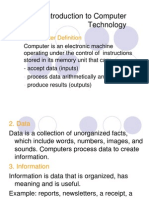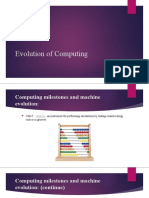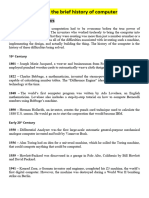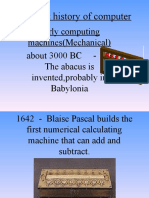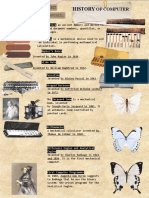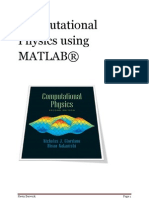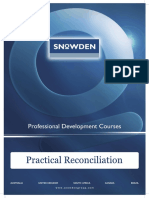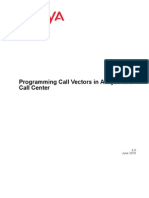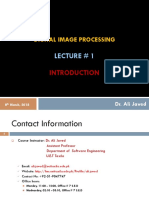History of Computers
History of Computers
Uploaded by
saifuddin_ariefCopyright:
Available Formats
History of Computers
History of Computers
Uploaded by
saifuddin_ariefOriginal Description:
Copyright
Available Formats
Share this document
Did you find this document useful?
Is this content inappropriate?
Copyright:
Available Formats
History of Computers
History of Computers
Uploaded by
saifuddin_ariefCopyright:
Available Formats
History of Computers
Originated as Calculating Machines
Abacus Babylonians 3000 B.C.
Napier's Bone
John Napier (1617 )
Multiplication and Division
Slide Rule
William Oughtred in England in 1632
Logarithm, roots
Most common before the the development of digital computers.
Until 1960s
Mechanical calculators
Schickard's Clock
German professor Wilhelm Schickard (1623)
Pascaline
Blaise Pascal (1642)
Punched card
Frenchman Joseph Marie Jacquard (1801)
Difference Engine
English mathematician
Charles Babbage (1822)
Steam driven
Polynomial , logarithmic ,
trigonometric functions
Never functional
Analytic Engine
1837
Powered by 6 stem engines
General purpose computer
Programmable and data stored
using Punched card technology of
Jacquard Loom.
Storage Unit called 'Store' and
processing unit 'Mill'.
Correspond to modern day CPU
and memory concept.
Conditional statement (different
from calculator)
Mark I
Harvard University and IBM (1944)
First fully automated digital
computer
Not purely electronic
Switches, rotating shafts,
clutches
hundreds of miles of wire, 16 m in
length, 2.4 m in height, It had a
weight of about 10,000 pounds
(4500 kg).
Operated on numbers 23 digits
wide.
add or subtract two of these
numbers inn 3/10 th of a
second,
multiply them in 4s, and divide
them in 10 seconds.
ABC computer
Earliest attempts to build an allelectronic (no mechanical parts)
digital computer in 1937 by J. V.
Atanasoff and Clifford Berry.
By 1941 they build a machine
that could solve 29 simultaneous
equations with 29 unknowns.
First to store data as a charge
on a capacitor memory
(same mechanism as DRAM).
Used binary arithmetic
ENIAC
Was the first general purpose
electronic computer
Ability of being reprogrammed for
different problems
University of Pennsylvania between
1943 and 1945 by two professors,
John Mauchly and J. Presper Eckert.
Got funding from the war department to
compute table for artillery gun
positions and was used in the
calculation for hydrogen bombs.
filled a 20 X 40 ft room, weighed 30
tons, and used more than 18,000
vacuum tubes.
Could only hold 20 numbers at a time.
Faster than the Mark I: a multiplication
that required 6 seconds on the Mark I
could be performed on ENIAC in 2.8
thousandths of a second.
Commercial Computers
Mauchly and Eckert set up their own company which produced the first commercial
computer the UNIVAC
(Universal Automatic Computer)
By 1955 IBM was selling more computers than UNIVAC
IBM model 650 is one of the first widely used computers.
In 1957 IBM 305 used magnetic disk for the storage (tapes were used prior to that)
1959 IBM introduced two desk-sized computers IBM 1401 for business and IBM
1620 for scientist.
The invention of transistors (which replaced vacuum tubes) and Integrated Circuit
(Texas Instruments) enabled the shrink in the size of computers
Programming languages
By 1959 more than 200 programming languages were
created.
1960 COBOL, - Grace hopper.
1965 John Kemeny of Dartmouth - BASIC programming
language
Microcomputers
By 1964 18,000 computers
1970 Large scale integration
Enabled the fabrication of large number of circuits in a single chip
I971 Microprocessors (uP) was invented in Intel
A microprocessor (uP) is a processing unit that is fabricated on an
integrated circuit (IC) or a chip.
Intel was the first to succeed in cramming an entire processing unit
on a single chip (IC).
The Intel 4004 was first such chip
In 1975 MITS Inc. produced
the first microcomputer, the
Altair using Intel 8080.
It was sold for less than $400.
Used Altair BASIC from
Microsoft
Developed by Bill Gates
and Paul Allen
1976 Steve Jobs and Steve
Wozniak build the first Apple
Computer
Hand built
Apple II (1977)
First successfully massproduced micro computers
1980 IBM offered microsoft to build operating
system.
Microsoft developed MS-DOS
IBM PC became the largest share in market for PCs
by 1981.
Helped the tremendous growth of microsoft
1984 Apple - Macintosh computer with
Graphical User Interface (GUI) and a mouse.
1992 microsoft released Windows 3.1
3,000,000 copies sold in 2 months
1993 several companies introduced computers by
using Pentium processors.
1990s 2000s
Yahoo, Amazon, ebay, were established.
Java programming language was developed by Sun
Microsystems
Google was founded in 1998
2003 myspace.com
2004 - facebook.com
2005 youtube.com
2004 Apple sleek iMac G5. System
unit housed inside the display box.
2006 Intel - Core 2 duo processors
family
2006 IBM fastest supercomputer
Blue Gene. 28 trillion calculations
in 1 / 10 th of a second
You might also like
- Assignment 1 - History of ComputerDocument3 pagesAssignment 1 - History of ComputerAnonymous w7r911SD78% (18)
- Lecture 1 - History of ComputingDocument43 pagesLecture 1 - History of ComputingRovell AsideraNo ratings yet
- Evolution of The ComputerDocument2 pagesEvolution of The Computerrajesh310198867% (3)
- 1-Evolution of ComputersDocument51 pages1-Evolution of ComputersShiela Mae BautistaNo ratings yet
- Introduction To Computer TechnologyDocument10 pagesIntroduction To Computer TechnologyVikas Sandhu100% (1)
- A Concise History of Computers, Smartphones and the InternetFrom EverandA Concise History of Computers, Smartphones and the InternetRating: 5 out of 5 stars5/5 (3)
- Fiitjee Phase Test PaperDocument21 pagesFiitjee Phase Test PaperPUBG INDIA FAN CLUB100% (4)
- Unit 1Document24 pagesUnit 1VaishNo ratings yet
- Information and Communication Technology ICTDocument31 pagesInformation and Communication Technology ICTSteve Marc InesNo ratings yet
- Computer History CSSDocument28 pagesComputer History CSSho are yoNo ratings yet
- Computer HistoryDocument3 pagesComputer HistoryNanda KishoreNo ratings yet
- Evolution of ComputingDocument21 pagesEvolution of ComputingMelx UbaldeNo ratings yet
- Living in It Era ReviewerDocument24 pagesLiving in It Era ReviewerAJ Love TanNo ratings yet
- Introduction To Computing: Topic: "History of Computer and Its Generations"Document12 pagesIntroduction To Computing: Topic: "History of Computer and Its Generations"Usama AkbarNo ratings yet
- History of ComputerDocument25 pagesHistory of Computerraffy segocioNo ratings yet
- Brief History of ComputersDocument8 pagesBrief History of ComputersArdy BellosilloNo ratings yet
- History of Computers513Document25 pagesHistory of Computers513Raquel Bona ViñasNo ratings yet
- History of Computers513Document25 pagesHistory of Computers513Rhenevoi Bastiero NonatoNo ratings yet
- Slide Rule:-: AbacusDocument19 pagesSlide Rule:-: AbacusSuvash RegmiNo ratings yet
- ... Is Computer HistoryDocument15 pages... Is Computer HistoryyonasminbiyewNo ratings yet
- Educational ComputingDocument17 pagesEducational ComputingJorgie Mae CruzNo ratings yet
- PRESENTATION-History and Evolution of ComputerDocument39 pagesPRESENTATION-History and Evolution of Computeriqrakhan00790% (21)
- It Application Tools in BusinessDocument22 pagesIt Application Tools in BusinessJames Ryan AlzonaNo ratings yet
- Assignment ChronlogyDocument10 pagesAssignment ChronlogyNouman1203No ratings yet
- History of Computers 513Document25 pagesHistory of Computers 513useblog03No ratings yet
- Lesson 2 History of ComputersDocument57 pagesLesson 2 History of ComputersNiña Gel Gomez AparecioNo ratings yet
- Describe The Brief History of ComputerDocument5 pagesDescribe The Brief History of Computersweetktz7890% (1)
- History of Computers JokhioDocument41 pagesHistory of Computers JokhioaliNo ratings yet
- History of ComputersDocument10 pagesHistory of ComputersChristy HabelNo ratings yet
- History of ComputerDocument13 pagesHistory of ComputerMuhammad HassanNo ratings yet
- HISTORY OF COMPUTERS AdditionalDocument4 pagesHISTORY OF COMPUTERS AdditionalSophia Yzabel PaduaNo ratings yet
- (It Bus) Computer HistoryDocument6 pages(It Bus) Computer HistoryRica Elaine LubasanNo ratings yet
- History of Computers513Document25 pagesHistory of Computers513Geneveve Casil FalconNo ratings yet
- Introducing Computer SystemsDocument95 pagesIntroducing Computer SystemsJethro GamadNo ratings yet
- History of ComputerDocument14 pagesHistory of ComputerKimfe VillajuanNo ratings yet
- When Was The First Computer InventedDocument8 pagesWhen Was The First Computer InventedMuhammad AliNo ratings yet
- History of ComputersDocument78 pagesHistory of ComputersWinnie MallillinNo ratings yet
- Computer History TimelineDocument7 pagesComputer History TimelineAnonymous qVBPAB3QwYNo ratings yet
- History of ComputerDocument29 pagesHistory of Computeravinmanzano100% (1)
- Computer History Year/Enter Computer History Inventors/ Computer History Description of EventDocument14 pagesComputer History Year/Enter Computer History Inventors/ Computer History Description of EventjobedanNo ratings yet
- The History of ComputingDocument7 pagesThe History of ComputingrockyroshanlimitedNo ratings yet
- Programming in C Chapter 1Document27 pagesProgramming in C Chapter 1samrat_2011No ratings yet
- cH1.1 Early Computing Devices HISTORYDocument19 pagescH1.1 Early Computing Devices HISTORYvinayakahospitaldigitalNo ratings yet
- History of Computing LectureDocument27 pagesHistory of Computing LectureSean YangNo ratings yet
- History of ComputerDocument3 pagesHistory of Computertheused0477No ratings yet
- Computer HTMDocument15 pagesComputer HTMM Shumraiz SharifNo ratings yet
- A Brief Computer HistoryDocument4 pagesA Brief Computer HistoryNerissa De LeonNo ratings yet
- Hist of CompDocument43 pagesHist of CompMichael John PedrasaNo ratings yet
- Timeline of The History of ComputersDocument5 pagesTimeline of The History of ComputersEden Ghie Briones - BanoNo ratings yet
- Evolution of ComputersDocument33 pagesEvolution of ComputerschuckpinoNo ratings yet
- History of Computers A Man Has Ever Made.Document6 pagesHistory of Computers A Man Has Ever Made.gracie18.troyo100% (1)
- Number System and EthicsDocument20 pagesNumber System and Ethicslyricssad057No ratings yet
- Evolution of The Computer:: Augusta AdaDocument4 pagesEvolution of The Computer:: Augusta AdaMadushanka TennakoonNo ratings yet
- Advanced Computer ArchitectureDocument160 pagesAdvanced Computer Architectureramnauts0100% (1)
- Computer Architecture and Organization: Unit - IDocument34 pagesComputer Architecture and Organization: Unit - IMegala SubramaniamNo ratings yet
- 3610 Lecture1 History of ComputingDocument28 pages3610 Lecture1 History of ComputingTolosa TafeseNo ratings yet
- History: of ComputerDocument3 pagesHistory: of ComputerElcie MateoNo ratings yet
- The Journey from the Abacus to the Smartphone | Children's Modern HistoryFrom EverandThe Journey from the Abacus to the Smartphone | Children's Modern HistoryNo ratings yet
- Coulomb and Earth PressureDocument6 pagesCoulomb and Earth Pressuresaifuddin_ariefNo ratings yet
- Essence of Geotechnical EngineeringDocument21 pagesEssence of Geotechnical Engineeringsaifuddin_ariefNo ratings yet
- A Very Basic Introduction To Scientific Python ProgrammingDocument33 pagesA Very Basic Introduction To Scientific Python Programmingsaifuddin_ariefNo ratings yet
- MathModeling03 PDFDocument350 pagesMathModeling03 PDFIrekNo ratings yet
- Large Open Pit Slope StabilityDocument53 pagesLarge Open Pit Slope Stabilitysaifuddin_ariefNo ratings yet
- Computational Physics Using MATLABDocument103 pagesComputational Physics Using MATLABDini Fakhriza A67% (6)
- Mining Geotechnics - A Glimpse Into DarkDocument49 pagesMining Geotechnics - A Glimpse Into Darksaifuddin_ariefNo ratings yet
- Practical ReconciliationDocument49 pagesPractical Reconciliationsaifuddin_ariefNo ratings yet
- Risk Management of Major Geotechnical StructuresDocument18 pagesRisk Management of Major Geotechnical Structuressaifuddin_ariefNo ratings yet
- A New Calculator and Why It Is NecessaryDocument16 pagesA New Calculator and Why It Is Necessarysaifuddin_ariefNo ratings yet
- Comparison of Slope Stability Methods of AnalysisDocument11 pagesComparison of Slope Stability Methods of Analysissaifuddin_arief100% (6)
- Using Spreadsheet To Learn Numerical MethodsDocument12 pagesUsing Spreadsheet To Learn Numerical Methodssaifuddin_arief83% (6)
- Behaviour of Slopes During EarthquakeDocument12 pagesBehaviour of Slopes During Earthquakesaifuddin_ariefNo ratings yet
- 9200 InglêsDocument473 pages9200 Inglêsposvendasdf5No ratings yet
- AISC Engg Journal 92 PDFDocument174 pagesAISC Engg Journal 92 PDFIlham setyabudiNo ratings yet
- DS0037 NKT Cables CB CC Screened T Connectors PDFDocument3 pagesDS0037 NKT Cables CB CC Screened T Connectors PDFromany allamNo ratings yet
- 14 MachinesDocument24 pages14 MachinesNdomaduNo ratings yet
- Naukri RajitVerma (24y 0m)Document2 pagesNaukri RajitVerma (24y 0m)Anitha NNo ratings yet
- GT 11. Modul Operating ProcedureDocument19 pagesGT 11. Modul Operating Procedurepraztt69No ratings yet
- Amicus Professional Manual enDocument6 pagesAmicus Professional Manual enelganchoNo ratings yet
- Wel 12 DDocument7 pagesWel 12 DWilly UioNo ratings yet
- Usol 160Document2 pagesUsol 160Victor RosuNo ratings yet
- Avaya VectorsDocument456 pagesAvaya Vectorsmohd_qureshi_4No ratings yet
- Revival of Ramagundam Fertilizer Complex Project: Pipe (CS, SS, As-Seamless)Document54 pagesRevival of Ramagundam Fertilizer Complex Project: Pipe (CS, SS, As-Seamless)arjun prajapatiNo ratings yet
- OBIEE - Dashboard Tips and Best Practice GuidelinesDocument6 pagesOBIEE - Dashboard Tips and Best Practice GuidelinesPani GummadiNo ratings yet
- Meiko Topic 20 OperatingDocument48 pagesMeiko Topic 20 Operatingathinabeba100% (1)
- 6493 1002 9838 3350 (BULK ORDERS) Tiny - CC/DCT - FB @dynacore: 81330458 (WhatsappDocument10 pages6493 1002 9838 3350 (BULK ORDERS) Tiny - CC/DCT - FB @dynacore: 81330458 (WhatsappChee JianzhiNo ratings yet
- b40 - b20v1 Technical Reference ManualDocument229 pagesb40 - b20v1 Technical Reference ManualJuan Angel Cerda GuerraNo ratings yet
- Well IsolationDocument2 pagesWell IsolationNaveed HasanNo ratings yet
- Data Sheet G08101374 Dussan PDFDocument2 pagesData Sheet G08101374 Dussan PDFWilliam AlvaradoNo ratings yet
- Transferring Thermal EnergyDocument2 pagesTransferring Thermal Energydestinystanley510No ratings yet
- Dieci Zeus 33.11 35.10 & 40.7 Spec SheetDocument4 pagesDieci Zeus 33.11 35.10 & 40.7 Spec SheetNash ServiceNo ratings yet
- Shear Wall ExampleDocument15 pagesShear Wall ExampleAnnamalai VaidyanathanNo ratings yet
- Features:: Protection Relays Closed Toroid For Residual Current ProtectionDocument1 pageFeatures:: Protection Relays Closed Toroid For Residual Current Protectionvinay kumarNo ratings yet
- Light: 1 Electromagnetic Spectrum and Visible LightDocument11 pagesLight: 1 Electromagnetic Spectrum and Visible LightAyushJaiswalNo ratings yet
- Construction Quality ControlDocument3 pagesConstruction Quality ControlJo M0% (1)
- Big Data Analytics PresentationDocument34 pagesBig Data Analytics PresentationRazvan Julian Petrescu100% (1)
- DIP Lec1Document61 pagesDIP Lec1Armughan AhmadNo ratings yet
- ANSI TIA 1019 Standard Instalasi StrukturDocument34 pagesANSI TIA 1019 Standard Instalasi StrukturWaskito Sukmo Widodo100% (1)
- TransposonDocument3 pagesTransposonArafa JebinNo ratings yet
- ResumeDocument3 pagesResumeswapnillohaniNo ratings yet
- Software Assurance Maturity Model (SAMM) Roadmap Chart TemplateDocument7 pagesSoftware Assurance Maturity Model (SAMM) Roadmap Chart TemplateSandi PrasetioNo ratings yet




